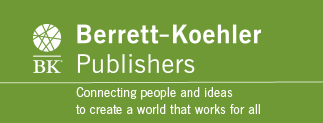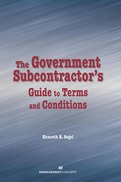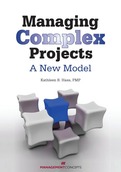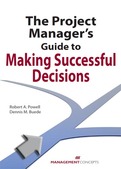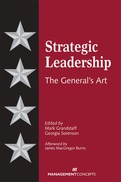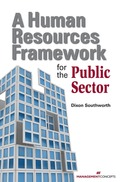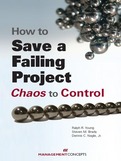Search Results: ""
Results 919-924 of 1358
Navigating Contract Terms and Conditions Just Got Easier!
Organizations are at risk when contract terms and conditions are not fully understood. The Government Subcontractor's Guide to Terms and Conditions quickly guides you through the process of reviewing and negotiating contracts, identifying terms and conditions of concern, and mitigating potential risks. Author Kenneth Segel has tapped over 20 years of contract experience to write a handbook that walks even the most junior contracts administrator through the daunting task of reviewing and negotiating a government contractor's terms and conditions.
This critical resource will help you
• Determine what specific terms and conditions to address
• Distinguish between a favorable and an unfavorable provision
• Address potentially damaging provisions
• Understand the potential economic impact of indemnification provisions
• Apply risk management to address indemnification provisions
The Government Subcontractor's Guide to Terms and Conditions will guide you through the inevitable challenges of the negotiation process. Put this updated resource to work in your organization today!
Organizations are at risk when contract terms and conditions are not fully understood. The Government Subcontractor's Guide to Terms and Conditions quickly guides you through the process of reviewing and negotiating contracts, identifying terms and conditions of concern, and mitigating potential risks. Author Kenneth Segel has tapped over 20 years of contract experience to write a handbook that walks even the most junior contracts administrator through the daunting task of reviewing and negotiating a government contractor's terms and conditions.
This critical resource will help you
• Determine what specific terms and conditions to address
• Distinguish between a favorable and an unfavorable provision
• Address potentially damaging provisions
• Understand the potential economic impact of indemnification provisions
• Apply risk management to address indemnification provisions
The Government Subcontractor's Guide to Terms and Conditions will guide you through the inevitable challenges of the negotiation process. Put this updated resource to work in your organization today!
For organizations to thrive, indeed to survive, in today's global economy, we must find ways to dramatically improve the performance of large-scale projects. Applying the concepts of complexity theory can complement conventional project management approaches and enable us to adapt to the unrelenting change that we ignore at our own peril.
Managing Complex Projects: A New Model offers an innovative way of looking at projects and treating them as complex adaptive systems. Applying the principles of complexity thinking will enable project managers and leadership teams to manage large-scale initiatives successfully.
• Explore how complexity thinking can be used to find new, creative ways to think about and manage projects
• Diagnose complexity on a wide range of projects — from small, independent, short projects to highly complex, longer projects
• Understand and manage the complexity of the business problem, opportunity, solution, and other dimensions that come into play when managing large-scale efforts
Use the Project Complexity Model to determine the most effective approach to managing all aspects of a project based on the level of complexity involved.
Managing Complex Projects: A New Model offers an innovative way of looking at projects and treating them as complex adaptive systems. Applying the principles of complexity thinking will enable project managers and leadership teams to manage large-scale initiatives successfully.
• Explore how complexity thinking can be used to find new, creative ways to think about and manage projects
• Diagnose complexity on a wide range of projects — from small, independent, short projects to highly complex, longer projects
• Understand and manage the complexity of the business problem, opportunity, solution, and other dimensions that come into play when managing large-scale efforts
Use the Project Complexity Model to determine the most effective approach to managing all aspects of a project based on the level of complexity involved.
Make Better Decisions While Managing Projects!
Decision-making is critical in project management. Lack of decision-making knowledge, avoidable mistakes, and improper definitions can negatively impact your company's ability to generate profit. The Project Manager's Guide to Making Successful Decisions is a practical handbook that focuses on the significance of project decision-making skills that will all you to reach workable and effective results. This valuable resource highlights numerous decisions necessary to support the project management life cycle, presents various techniques that facilitate the decision-making process, provides an overview of decision analysis as it relates to project management, and much more!
+ Understand different types of decision-making processes and cycles
+ Recognize how to frame the decision and gather better information
+ Define alternatives and assessments to make the right decision
+ Analyze short case studies demonstrating project decision making success
Decision-making is critical in project management. Lack of decision-making knowledge, avoidable mistakes, and improper definitions can negatively impact your company's ability to generate profit. The Project Manager's Guide to Making Successful Decisions is a practical handbook that focuses on the significance of project decision-making skills that will all you to reach workable and effective results. This valuable resource highlights numerous decisions necessary to support the project management life cycle, presents various techniques that facilitate the decision-making process, provides an overview of decision analysis as it relates to project management, and much more!
+ Understand different types of decision-making processes and cycles
+ Recognize how to frame the decision and gather better information
+ Define alternatives and assessments to make the right decision
+ Analyze short case studies demonstrating project decision making success
Strategic Leadership
2008
Think Like a General…Lead Like an Executive
“At their center, great organizations such as America's armed forces are the product of great leaders. This fantastic book reveals the keys to success within the military culture, as well as relevant and practical application tools for creating strong leaders today.”
—Stephen R. Covey, author of The 7 Habits of Highly Effective People and The 8th Habit: From Effectiveness to Greatness
What distinguishes strategic leadership? According to top U.S. Army generals, the difference lies in the discipline of thinking. Because the problems strategic leaders face are often multi-faceted and can involve ethical dilemmas, these leaders must move beyond thinking tactically and take a longer term, broader approach to finding solutions. Through the U.S. Army War College and other senior-service colleges, the Army teaches strategic thinking to its officers, developing some of the most esteemed leaders of our time.
Strategic Leadership: The General's Art provides aspiring leaders with an understanding of the behavior and competencies that make a good strategic leader. In line with the curriculum followed by senior officers attending the U.S. Army War College, this book teaches leaders how to think strategically in a volatile, uncertain environment and thereby to provide transformational leadership and shape outcomes.
With contributions from senior military leaders as well as experts in the fields of strategic leadership, systems and critical thinking, and corporate culture, this invaluable reference shows readers how to move from mid-level manager to strategic-thinking senior executive.
Strategic Leadership: The General's Art provides aspiring leaders with an understanding of the behavior and competencies that make a good strategic leader. In line with the curriculum followed by senior officers attending the U.S. Army War College, this book teaches leaders how to think strategically in a volatile, uncertain environment and thereby to provide transformational leadership and shape outcomes.
With contributions from senior military leaders as well as experts in the fields of strategic leadership, systems and critical thinking, and corporate culture, this invaluable reference shows readers how to move from mid-level manager to strategic-thinking senior executive.
“At their center, great organizations such as America's armed forces are the product of great leaders. This fantastic book reveals the keys to success within the military culture, as well as relevant and practical application tools for creating strong leaders today.”
—Stephen R. Covey, author of The 7 Habits of Highly Effective People and The 8th Habit: From Effectiveness to Greatness
What distinguishes strategic leadership? According to top U.S. Army generals, the difference lies in the discipline of thinking. Because the problems strategic leaders face are often multi-faceted and can involve ethical dilemmas, these leaders must move beyond thinking tactically and take a longer term, broader approach to finding solutions. Through the U.S. Army War College and other senior-service colleges, the Army teaches strategic thinking to its officers, developing some of the most esteemed leaders of our time.
Strategic Leadership: The General's Art provides aspiring leaders with an understanding of the behavior and competencies that make a good strategic leader. In line with the curriculum followed by senior officers attending the U.S. Army War College, this book teaches leaders how to think strategically in a volatile, uncertain environment and thereby to provide transformational leadership and shape outcomes.
With contributions from senior military leaders as well as experts in the fields of strategic leadership, systems and critical thinking, and corporate culture, this invaluable reference shows readers how to move from mid-level manager to strategic-thinking senior executive.
Strategic Leadership: The General's Art provides aspiring leaders with an understanding of the behavior and competencies that make a good strategic leader. In line with the curriculum followed by senior officers attending the U.S. Army War College, this book teaches leaders how to think strategically in a volatile, uncertain environment and thereby to provide transformational leadership and shape outcomes.
With contributions from senior military leaders as well as experts in the fields of strategic leadership, systems and critical thinking, and corporate culture, this invaluable reference shows readers how to move from mid-level manager to strategic-thinking senior executive.
An Entirely New Way to Look at Human Resources in the Public Sector
What makes a good worker? Why do some people naturally do well at their jobs while others struggle? These questions are at the heart of the human resource (HR) profession. And while there is no shortage of theories about how people achieve success, no one has explained the entire body of HR theories. Until now.
In A Human Resources Framework for the Public Sector, Dixon Southworth offers a fresh, new perspective on HR management with the first comprehensive theoretical framework for work performance, tying human resource theories, concepts, and concerns to public administration. With the introduction of the Work Performance Framework (WPF), Southworth offers a roadmap for work performance in the nonprofit and public sectors that focuses on three fundamental objectives of HR programs and services: build human resource capacity, build performance, and build community.
What makes a good worker? Why do some people naturally do well at their jobs while others struggle? These questions are at the heart of the human resource (HR) profession. And while there is no shortage of theories about how people achieve success, no one has explained the entire body of HR theories. Until now.
In A Human Resources Framework for the Public Sector, Dixon Southworth offers a fresh, new perspective on HR management with the first comprehensive theoretical framework for work performance, tying human resource theories, concepts, and concerns to public administration. With the introduction of the Work Performance Framework (WPF), Southworth offers a roadmap for work performance in the nonprofit and public sectors that focuses on three fundamental objectives of HR programs and services: build human resource capacity, build performance, and build community.
You CAN Turn Around A Failing Project!
Poor project results are all too common and result in dissatisfied customers, users, and project staff. With countless people, goals, objectives, expectations, budgets, schedules, deliverables, and deadlines to consider, it can be difficult to keep projects in focus and on track. How to Save a Failing Project: Chaos to Control arms project managers with the tools and techniques needed to address these project challenges. The authors provide guidance to develop a project plan, establish a schedule for execution, identify project tracking mechanisms, and implement turnaround methods to avoid failure and regain control.
With this valuable resource you will be able to:
• Identify key factors leading to failure
• Learn how to recover a failing project and minimize future risk
• Better analyze your project by defining proper business objectives and goals
• Gain insight on industry best practices for planning
Poor project results are all too common and result in dissatisfied customers, users, and project staff. With countless people, goals, objectives, expectations, budgets, schedules, deliverables, and deadlines to consider, it can be difficult to keep projects in focus and on track. How to Save a Failing Project: Chaos to Control arms project managers with the tools and techniques needed to address these project challenges. The authors provide guidance to develop a project plan, establish a schedule for execution, identify project tracking mechanisms, and implement turnaround methods to avoid failure and regain control.
With this valuable resource you will be able to:
• Identify key factors leading to failure
• Learn how to recover a failing project and minimize future risk
• Better analyze your project by defining proper business objectives and goals
• Gain insight on industry best practices for planning
